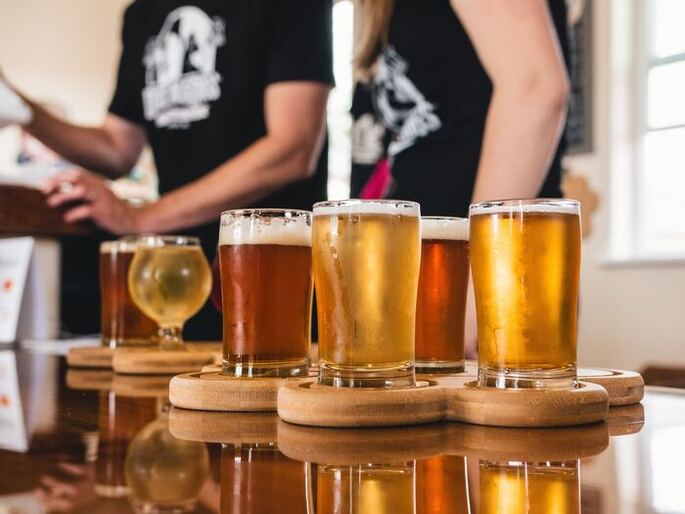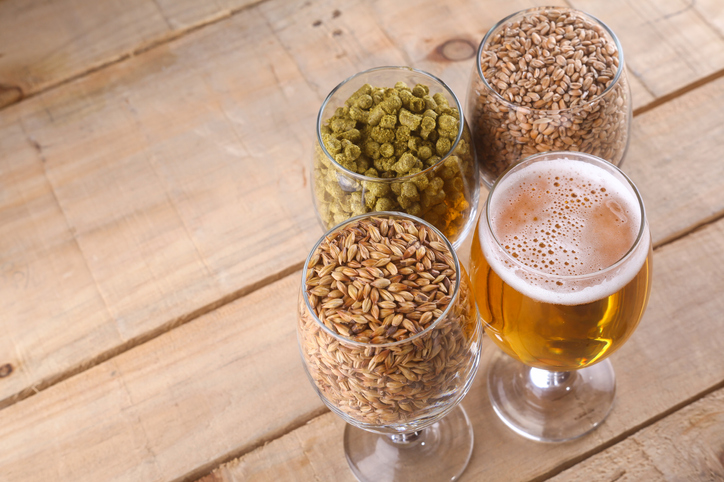For countless enthusiasts, home brewing has become more than just a pastime; it’s an art form intricately tied to brewing safety. It offers a chance to experiment, innovate, and bask in the pride of creating a beverage that’s uniquely theirs. Each batch embodies hours of careful planning and safety considerations, from selecting the perfect blend of malts and hops to ensuring proper precautions during fermentation, all in the quest for that unparalleled taste.
Yet, behind the scenes of this captivating craft lies an equally significant narrative about safety. Brewing, while deeply rewarding, comes with its own set of hazards. The high temperatures involved, the handling of potentially breakable equipment, and even the chemicals used for sanitization all introduce risks. It’s essential for every home brewer, whether a novice or seasoned, to understand these challenges. Balancing the meticulous brewing process with a safety-first approach ensures that the joy of the craft remains undiminished and each sip reflects expertise and diligence.
The safety guide for every home brewer
Picture this: you’re engrossed in the brewing process, the aromatic scent of hops fills the air, and the bubbling wort seems to be singing a promise song. Yet, in this very moment, a slight misjudgment can lead to spillages or even burns. The boiling creations we so lovingly prepare can, in a heartbeat, become sources of potential harm if we’re not cautious.
Safety isn’t about instilling fear but fostering respect for the process. Just as a seasoned chef wouldn’t downplay the importance of handling a knife carefully, brewers should be equally vigilant about their surroundings. This isn’t limited to just the brewing procedure. The aftermath, which involves storing and fermenting, requires its own set of safety guidelines. Every detail matters from ensuring that bottles are securely sealed to making sure fermentation vessels are placed where they won’t be knocked over.
Now, let’s take a brief detour and consider the broader implications of home brewing. Beyond the immediate physical risks, there’s also the matter of potential property damage. Imagine a scenario where an unchecked fermentation leads to an overflow or an explosion. There is a mess to contend with and potential damage to your home’s interiors. Without raising alarm bells, it’s worth noting that these unforeseen incidents can have financial ramifications.
This is where safeguarding your assets subtly comes into play. Just as we’d protect a treasured collection or a valuable piece of art, the domain we brew, our homes, deserve consideration. It’s prudent to ensure that, in the realm of what-ifs, one’s abode and brewing equipment are covered, offering peace of mind amidst the whirlwind of brewing adventures.
While exciting, navigating the realm of home brewing is also sprinkled with unforeseen incidents that can have repercussions beyond the brew pot. And while our focus often remains on perfecting the beer, the space we brew in—the heart of our homes—shouldn’t be overlooked. A robust home insurance policy becomes an unsung hero in this tale. It serves as a protective net, cushioning the brewer from potential financial strains that could arise from accidental damages. Whether it’s a fermenter overflowing, causing water damage, or a brewing rig mishap leading to property damage, having the right coverage ensures that unexpected financial burdens don’t dampen passion.
In essence, brewing is a journey—one replete with rewards and challenges in equal measure. We don’t dilute the passion by weaving safety measures seamlessly into our brewing tapestry. Instead, we bolster it, ensuring that every sip of our home-crafted beer is delightful and a reflection of expertise and diligence.

Expert insights on prioritizing brewing safety
Whether you’re a budding home brewer or looking to elevate your brewing techniques, the wisdom from our seasoned experts will steer you toward a safer and more refined brewing experience.
When choosing and buying home brewing equipment, what should I consider to ensure the quality of my brew and a safe brewing process?
“Getting the right home brewing gear is a bit like setting up a home studio for a band. You need the right instruments to play the tunes you love. When it comes to material, stainless steel is the rockstar. It’s tough, easy to clean, and won’t mess around with your brew. As for the size, it’s a bit like choosing the right venue. You want a place that fits your crowd but with a little extra room to dance. So, choose equipment that matches the volume you plan to brew with a bit of room to spare.
Temperature control is your sound check. It’s crucial for hitting the right notes during different stages of brewing. Now, onto cleanliness. Imagine it’s like keeping the band’s gear in top shape, ready for every gig. Your brewing equipment should be easy to clean and sanitize to ensure every batch is a headliner. When it comes to automation, that’s your roadie, making sure everything runs smoothly and on time. A system that offers a degree of automation can take off some of the pressure on the brew day.
Looking ahead, if you plan on going big, consider gear that’s expandable or modular, so you don’t have to start from scratch when you want to upscale. And don’t forget to jam with other homebrewers or join a homebrew club. Sharing experiences and getting recommendations on gear can save you from a few sour notes. Lastly, keep an eye on the legal landscape, ensuring your setup dances to the tune of local laws and regulations. Happy brewing!”
Karl Steinmeyer from The Homebrew Academy
How can one ensure the safe and optimal dispensing and refrigeration of homebrewed beer, and what are the best practices to maintain the beer’s integrity during these stages?
- “Consistent temperature levels during fermentation, conditioning, and while tapped for dispense are critical to maintaining freshness, flavor, and carbonation level. Do everything you can to avoid temperature fluctuations.
- Draft line and faucet cleanliness are the likeliest things to negatively impact beer quality post-packaging. Ensure you flush and clean your lines every 2 weeks. Soak, scrub, and sanitize your faucets at least this often, ideally once per week.
- Oxidation is the next most likely thing to impact quality. This will happen naturally the longer the keg sits but can also be a result of improper packaging/handling.
- Once your beer is carbonated to spec, do not open the lid of the keg (assuming the use of corny-style kegs) if it can be avoided. Purge oxygen from the keg when carbonating by pulling the relief valve open for 2-4 seconds while the keg is attached to CO2, allow gas to flow in, and repeat that process a few times.
- It’s important to follow proper packaging processes when putting beer into kegs, with the goal being to eliminate oxygen in the keg at all stages.
- I would suggest looking to the Brewers Association or other industry resources for more detail on all topics above.”
Kyle Chittim from Perlick Corporation
How do safety measures, particularly in handling ingredients and equipment, impact the taste and character of homebrewed beer, and what strategies can I adopt to ensure a safe yet flavorful brew?
“When we are talking about safety with regards to ingredients and equipment, our primary areas of focus are going to be cleanliness, quality of said ingredients, and proper handling of equipment.
Whether you are brewing on a production scale or at home, you’re utilizing some form of detergent to clean your equipment of any debris and bacteria and then a sanitizer to ensure that foreign microbes aren’t going to take residence while the equipment awaits green beer. Anytime you are working with chemicals, it’s important to be aware of the proper concentration you should be using to a.) ensure the chemical is going to be able to fully perform its purpose and b.) avoid a potentially dangerous situation of an over-concentrated chemical leaving problematic residues.
As for ingredients, obviously, we want to ensure our malt, or any ingredient for that matter, is free from any pests, mold, or anything of that nature. Many compounds that result from the presence of these things can end up downstream in the finished beer and be potentially harmful but definitely adverse to producing a quality-tasting beer.
In brewing, we often work with pressure; whether that be a low-pressure system or a high one, it’s an area where we need to exhibit caution and be aware. With homebrewing specifically, this is going to apply if you are kegging or bottling. Recognizing these potential hazards and having proper equipment can help ensure you are making good beer and staying safe.”
Reid Ackerman from Ghostfish Brewing Company
How do I prevent common mistakes that might jeopardize the safety of my brew or my well-being?
“During fermentation, the yeast converts sugars into alcohol and CO2. The CO2 converts into carbonic acid, which lowers the pH of the beer. Both alcohol and low pH inhibit pathogenic microbes. Don’t skimp on your yeast! It is important to pitch a sufficient amount of high-quality and healthy yeast to ensure that the beer is stabilized rapidly by yeast metabolism. Don’t attempt to make very low-alcohol beers at home (< 3% abv) since these types of beers are more prone to allowing the growth of pathogenic bacteria (commercial breweries will stabilize these styles with pasteurization). When cleaning your equipment, opt for a no-rinse, food-safe sanitizer. Avoid chlorine-based cleaners and never mix bleach with acid-based cleaners (this will result in the formation of toxic chlorine gas). For more support with your brewing, join a local or online homebrewing community, ask questions to your local homebrew shop, or contact the brewing experts at Lallemand Brewing where we support commercial and homebrewers alike.”
Eric Abbott from Lallemand Brewing
What principles or safety standards from large-scale brewing can be adapted or scaled down to ensure quality and safety in a home brewing setting?
“As a cider maker who started as a home hobbyist making 5-gallon batches – I can say that there are a lot of lessons from scaling up that apply! First of all and no surprise, it’s keeping things super clean – sanitize everything the cider touches! Specific to cider if you are pitching a specific strain of yeast vs a wild ferment is how you get your juice ready to pitch. On a small scale sulfiting and then waiting 48 hours to pitch yeast is a common way of doing it. Schilling does not add any sulfites so we flash pasteurize prior to pitch. Heating the juice to 150f for 15 minutes is a reasonable way to do that at home too if you do not want to use sulfites.
The next step that’s specific to cider is how to preserve it once it’s done. If you plan to back sweeten or stop the fermentation early, you will have residual sugar that will want to referment in the bottle. Schilling has a tunnel pasteurizer where the cans filled with cider get heated and held at a certain temperature that kills all bacteria and yeast that may be present in the can creating long-term stability with no chemicals. This can also be done at home with some real attention to detail in a water bath. It is critical if your cider is carbonated that you do not overheat it or it may explode. I would recommend a water bath at 150F for 15 minutes (15 minutes once the bath is at equilibrium). Do not go hotter and ensure your bottles are high-pressure rated with the correct headspace! Please take all possible precautions as if done wrong you can have exploding glass and hot water which is a dangerous combo! There are chemical alternatives to this process that work, but to my palette degrades the taste.”
Collin Schilling from Schilling Cider
With the complexities of managing chemicals, pressure vessels, boiling liquids, and electrical devices simultaneously in homebrewing, what are your top recommendations for maintaining utmost safety without compromising the brewing quality?
“When it comes to safety, there are several substantial risks in brewing, and each can be addressed with appropriate steps. These are:
-Safety with respect to chemicals: With chemicals the main risk is getting them on your skin or in your eyes. Protective eyewear is a good idea when using acid, caustic, or oxidizing substances. All three types are common in the industry. At a minimum, some chemically resistant gloves are a good idea.
-Safety with respect to handling hot liquids:
Brewery requires us to use liquids that are boiling hot. The main risk when using these hot liquids is to make sure pots can’t fall over. We are designed with heavy weights and large amounts of liquid and hot grains. Once again the chemically resistant gloves are good as they also prevent you from getting burns to your hands. The other thing is to make sure you are always working on a flat-level surface. Castor wheels on devices can be risky so if you want to use castor wheels always lock them before using the brewery and also make sure the castor wheels are substantially wider than the brewery/fermenter/pot diameter. For instance, notice how these dolly wheels have a wider base than the brewery itself. This is ideal.
-Electrical Safety: Obviously when using high-amperage devices that contain liquid there are some inherent dangers. Some things to keep an eye on are:
1. Ensure you have property-earthed vessels. For any electrical device, all metal parts for that electrical device you can touch with your hand should be earthed. I have attached a photo showing how this can be done with a multimeter. What we want to check is that the earth terminal on the plug has “continuity” with the stainless steel vessel. Some multimeters will make a beeping sound when you join the two. Alternatively, if you check the resistance, the resistance should be close to zero (or less than a couple of ohms). Any decent manufacturer of electrical hardware should check this during the manufacturing process, but if you have made the brewery yourself or you purchased a second-hand device, I would definitely take the time to check this as it’s the single most important electrical check.
2. Ensure you have taken precautions to separate electrical and liquids. This may sound obvious, but you really have to look at the likely failure modes in a brew day. Things that are spilling over, boiling over, or hoses getting intentionally or accidentally disconnected. When this happens and liquid spills where is the liquid going to go? Try and keep AC power cables as far away from the wet areas or areas where the liquid is likely going to spill.
3. Use properly rated extension cables. Most brewery hardware draws a lot of amps. As a result, you need to make sure sufficient copper thickness is used, and you are not going to burn out your connections. Generally speaking, your household power cables will be made to a certain electrical standard. With that said customers often have extension cables or double adaptors that are old, worn out, or simply insufficient thickness to do the job, resulting in fire risk or wasted power. Often, people are brewing outside and using cheap extension cables with thin internal wires. The longer and thinner the power cables the more loss you will have too. So customers who are using long and poor-quality extension cables may notice the brewery itself is not getting a vigorous boil, or it’s slow to heat up; this is also a telltale sign. If you feel the cable and it’s getting warm to the touch, this is also a good indication your extension cable is not of suitable thickness for the high-powered device, or possibly it’s too long.
-GAS Safety: Probably the safest thing you can do is to simply get rid of gas altogether. Gas does have its safety concerns and generally speaking on a home scale there is no reason to use gas so simply upgrading to an electric brewery is probably one of the fastest ways to improve safety. If however, you have a large brewery that requires more power than what you can deliver using your electrical system gas may be required. If you can’t get enough power through your home power connection and are forced to use gas, then the main things you need to check are:
1. Make sure you do not have gas leaks. Do a pressure check to make sure all your gas lines hold pressure.
2. Ensure that either your gas flame cannot blow out. If there is a chance that your flame might blow out then you really should have a thermal switch or gas control valve with a thermocouple on it so if the flame goes out, it doesn’t fill the room with gas.
3. Ensure the flame is burning efficiently. If you are getting yellow flames or carbon builds up on your pots, this is a good indication that you have an inefficient burn and wasting gas, but more importantly, you most likely generate carbon monoxide which is highly dangerous especially if you are using the burner without good airflow.”
Kee Doery from KegLand

What essential safety guidelines should I follow for the fermentation and storage of my homebrewed beer?
“Fermentation and Storage:
Luckily the pH of beer makes it resistant to pathogenic bacteria. Proper cool or cold storage away from light is about maintaining fresh flavor rather than any risk of food-borne illness. That said, there are other potential safety when it comes to fermenting and storing your homebrew.
Ensure that the carbon dioxide (CO2) produced during fermentation is able to vent from the fermenting vessel. Trapped CO2 can rapidly build enough pressure to destroy your fermentor and cover your ceiling in beer. If your fermentor is not large enough to accommodate the foam produced during peak krausen, attach a wide-diameter blow-off tube that will not be blocked by yeast, hops, fruit etc.
If using a glass carboy, ferment it in a place where you will not need to move it after filling it. Alternatively, place it in a milk crate, or attach straps that will allow you to safely move the carboy without dropping it.
If spunding a beer to develop natural carbonation, always use a pressure vessel with an emergency pressure relief valve affixed that will let off excess pressure before reaching the structural limits of the vessel.
When cleaning a keg or fermentor, do not seal it up while it is hot without putting pressure on it. This can create a vacuum as it cools and implodes it.
If aging your beer in a fresh spirit barrel, do not attempt to sanitize it with a sulfur wick like a winemaker might. The alcoholic vapor can ignite with deadly force.
Ensure the beer is completely finished fermenting before packaging. Generally, you want to be close to the maximum suggested temperature for the yeast strain to ensure it doesn’t stall. Record identical gravity readings for three days before packaging. Dry hopping at warm temperatures can lead to additional attenuation as the hops contain enzymes that free sugars for fermentation. Be careful when using “hyper-attenuative” yeast strains like Brettanomyces, which can slowly continue producing carbon dioxide. I’d suggest stable gravity readings month-over-month.
After packaging, prevent your bottles/kegs from getting significantly warmer than room temperature. Higher temperatures increase pressure significantly. Leaving bottles in a warm car in the summer could lead to explosive results. It isn’t good for the flavor of the beer anyway!”
Michael Tonmseire from The Mad Fermentationist
What are the key differences between root beer and PA Dutch birch beer?
“Ingredients: The main difference between these beverages in birch beer is made with birch bark, and root oil is the primary ingredient in root beer. Originally, manufacturers used the root oil from the sassafras plant, but the Food and Drug Administration (FDA) has since banned it for being linked to cancer. Today, root beer can be made from the root oil of just about any other plant, the most popular options being acacia, licorice root, wintergreen root, ginger, or cloves. In addition, birch beer uses strictly natural ingredients. While root beer manufacturers may add some additional oils and herbs to enhance the flavor, birch beer contains no root extracts. All ingredients are collected from the wild.
Taste: Though it’s subtle, the taste between the two is slightly different. They are both sweet and minty, but birch beer’s flavor is more complex. Depending on the root oil used, the taste of root beer might vary from brand to brand; but there’s less variability in the flavor of birch beer across brands because it’s always made from sweet birch bark. This is what elevates PA Dutch birch beer over root beer for some soda drinkers. With the exception of intentional variations in flavor, you’ll always know what to expect when cracking open some birch beer. The same can’t be said for root beer.
Popularity: Oddly enough, the popularity of these drinks is unique to different regions around the country. In the US, birch beer is most popular in the eastern states, especially northeastern states like Maine, Pennsylvania, and New Jersey. While the market for birch beer isn’t restricted to these areas, it is seemingly more popular in the northeastern states because this is primarily where sweet birch trees grow. It’s easy for manufacturers to produce and distribute to these states because awareness of birch beer is higher.
Root beer can be made from the root oil of just about any plant, so its popularity tends to be universal across the US. It’s also available outside of the US in the United Kingdom, Australia, and some Asian countries.”
The Markets at Shrewsbury Team from The Markets at Shrewsbury
What are your best recommendations for handling and preserving my homebrewed beer once it’s brewed to perfection?
“Maintaining the flavor and freshness of your craft brews is essential for a satisfying experience. Here are some key tips:
- Temperature Control: Store your beer in a cool, consistent temperature environment. Fluctuations can lead to off-flavors. Aim for 2-6°C.
- Bottle Conditioning: Allow your beer to carbonate naturally by adding priming sugar before bottling. This promotes longevity and complexity in flavor.
- Dark and Dry: Shield your beer from light exposure. Store bottles in a dark place and keep them dry to prevent label damage and rust.
- Airtight Seal: Ensure a proper seal on bottles or kegs to prevent oxidation. Use quality caps and seals to maintain carbonation.
- Limited Oxygen: When transferring or bottling, minimize oxygen exposure. Use a siphon or CO2 to reduce contact.
- Aging: Some styles benefit from aging. Experiment with aging periods, but monitor regularly to prevent spoilage.
- Hygiene: Sanitize equipment thoroughly to prevent contamination.
- Rotation: Consume your homebrew within a reasonable timeframe to enjoy its freshness.
- Experiment: Explore various techniques and ingredients to find what best suits your taste and preservation needs.
By following these tips, you can savor your homebrewed beer long after it’s crafted. ”
Diego Masiero from Beer Awards Platform
How can I ensure that my brewing setup is ergonomically designed to minimize strain and potential injury during extended brewing sessions?
“The beauty in brewing is that a lot of it is hurry up and wait, however, this doesn’t mean there is no risk in carrying things around. Water and heat are two major hazards leading to lifting strain and the risk of scalding. In an ideal situation, you should only really be dealing with filling up vessels, not necessarily moving them around. Having a fixed frame with a 3-vessel setup installed on top of it is ideal as the vessels are fixed in place on a metal frame. It’s a more expensive approach, but it’s both safe and consistent. With 3 vessels, you are dealing with a hot liquor tank, a mash tun, and a kettle.
What are the common issues in the brewing process and how can I address them?
“There are many issues that could occur during the brewing process. Over the years, the brew team at Daft has experienced many issues as we familiarized ourselves with the limitations of our brewhouse. For example, the dreaded ‘stuck mash’.
A stuck mash occurs when the grains in the mash tun (the tank that extracts sugars from crushed grains) do not allow liquid to pass. Instead of acting as a filter to remove solid particles, they act as a blockage that prevents liquid from draining from the tank. Adding rice hulls to the mash can help to prevent a stuck mash. If a grain-heavy recipe gets stuck and contains rice hulls already, it’s not fun. The solution? Next time, add more rice hulls!
There are many small issues that can occur during the brewing process – the best path to resolution is to identify them as they come up and put processes in place so the issues can be avoided in the future. A mindset for continuous improvement is the only way for a brewer and brewery to grow.”
Adam Rondeau from Daft Brewing
Which precautions should I take when handling hot liquids, boiling worts, and working with open flames during brewing?
“When working during the boil of a brew it’s always best practice to not turn your back on the kettle when the flames are lit. The kettle could boil over and spill boiling hot liquid which for obvious reasons could be quite harmful but also make a mess and nobody likes cleaning up sticky, caked-on wort off of a stove or burner. Equipment-wise, using silicone tubing for transferring hot liquids is a must as regular vinyl siphon tubing will not stand up to the temperature of boiling wort or water, and for handling any grain bags or hop spiders in the boil or the kettle itself, a heavy-duty pair of rubber gloves is a very good idea.”
Andrzej Bzdula from Love2brew
How do I guarantee that my beer is adequately carbonated and conditioned to achieve the best taste and quality?
“Carbonation is essential to guarantee the quality and final taste of your homebrewed beer, and conditioning beer in the right way is the only way homebrewers can ensure a well-carbonated and tasty beer.
The carbonation in beer is formed when the yeast transforms the sugar into CO2, and this process happens naturally during conditioning when you leave your beer bottles to rest for a few weeks. While conditioning beer may sound simple because you only need to let your beer bottles sit, there’s a lot of science behind it.
The amount of sugar added will affect how carbonated your beer is, so the more sugar you add, the more CO2 the yeast will be able to produce.
Yeast needs the right temperature to transform sugar into CO2. When conditioning beer, you need to place your beer bottles in a lukewarm location. It should be no less than 65ºF but ideally over 70ºF. This is very important to consider when you want to make sure your beer will have the desired taste and quality. If the temperature is too low, it might take longer for the yeast and sugar to create CO2, which may affect the taste and carbonation.
To ensure the best taste and quality, the conditioning period should last at least 2 weeks, but ideally, you want to wait for 3 weeks to make sure all the yeast and sugar have been transformed into CO2. Otherwise, you will end up with a beer that still has yeast and sugar, and it won’t taste good. You will be able to see the yeast settle at the bottom of the beer bottle, and until it has disappeared, the beer is not ready.”
Mark Simons from The Beer Exchange
What precautions should I prioritize during the initial ingredient mixing and preparation phase of homebrewing to set a safe foundation for the entire process?
“When brewing beer, it is essential that the wort (The material that will be placed in the fermenter with the yeast.) is sterile. This is for a couple of reasons. First, so the yeast doesn’t have to compete with other microorganisms for the sugar it will convert to alcohol. Second, other yeasts, fungi, and bacteria can make molecules that give the beer an off flavor. Because all beer recipes call for boiling the wort before placing it in the primary fermentation vessel, it is not necessary to take any special precautions before this step. Boiling both sterilizes the wort and gives an opportunity to add hops for flavoring. The most crucial time to be careful with sterility is when putting the material into the primary fermenter and adding the yeast. This is the most likely place for contaminating microorganisms to get into the mix. So, it is essential that any material that might come into contact with the post-boil wort is sterile. This includes the fermentation vessel, the airlock, and even the outside of the yeast package. The primary fermentation will generate enough alcohol to kill most microorganisms. However, there are some bacteria that can survive at the alcohol concentrations in beer, and some of them can convert alcohol to vinegar. For that reason, I am also careful to sterilize any vessel the beer will go into a secondary fermenter, a keg, or bottles.”
Mike Tibbetts from Clover Brooke Farm
How do the latest innovations in brewing equipment and techniques assist in enhancing the safety protocols for homebrewers like me?
“The latest innovations in brewing equipment and techniques have greatly enhanced things for homebrewers, providing them with tools and knowledge to brew with confidence.
1. Precision Temperature Control: Advanced temperature control systems in modern brewing equipment help maintain consistent and safe brewing temperatures, preventing unwanted bacterial growth or flavors.
2. Sanitization Advancements: Homebrewers now have access to more effective sanitization methods and products. UV-C sanitizers, ozone generators, and no-rinse sanitizers make it easier to keep brewing equipment and surfaces clean and safe.
3. Monitoring: New brewing systems can monitor crucial parameters like pH, gravity, and fermentation progress, sending alerts to your phone if something goes wrong. This real-time data enhances control 4. Internet Resources & Videos: The digital age has brought an abundance of web-based resources, forums, and communities for homebrewers to share knowledge and best practices. This collective wisdom helps novices avoid common mistakes. In summary, these innovations empower homebrewers to produce higher-quality beer with fewer safety concerns. With advanced equipment and the collective knowledge of the brewing community, homebrewing has become a way more enjoyable hobby.”
Ryan Phillips from Brewcraft
As we delve deep into the world of home brewing, it’s clear that nurturing your hobbies is about more than just the sheer joy of creation. It’s about recognizing the delicate balance between passion and precaution. Each step in the brewing process, from ingredient selection to fermentation, offers an opportunity to infuse safety and expertise, ensuring that our dedication is mirrored in the quality of the brew.
Similarly, just as we’d carefully select the right lighting for every room to create the perfect ambiance, we must also shine a spotlight on the intricate details of brewing safety. Understanding the subtleties, from equipment care to the right storage techniques, ensures a brewing experience that’s as safe as it is satisfying.




